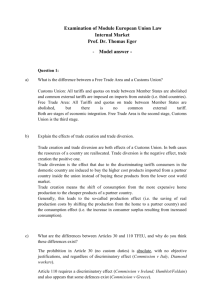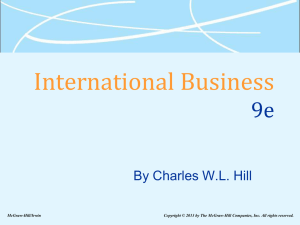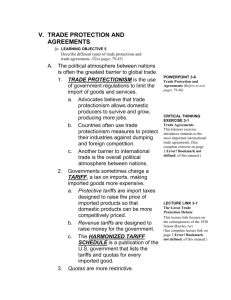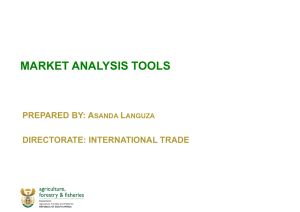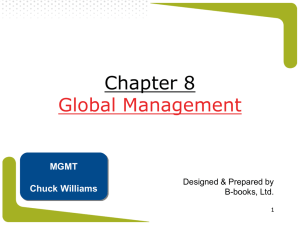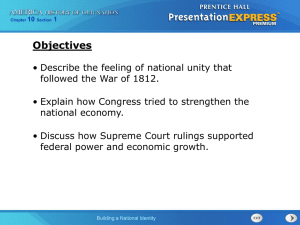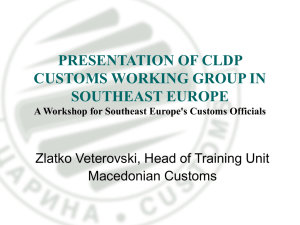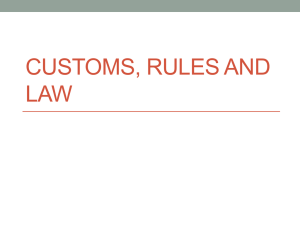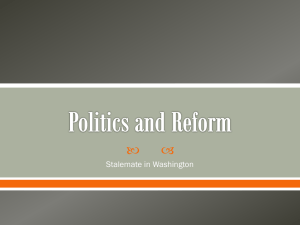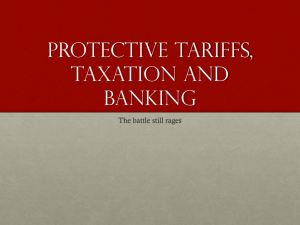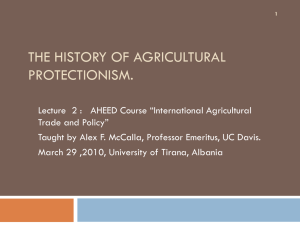The Global Trade Environment Pribanus Wantara
advertisement
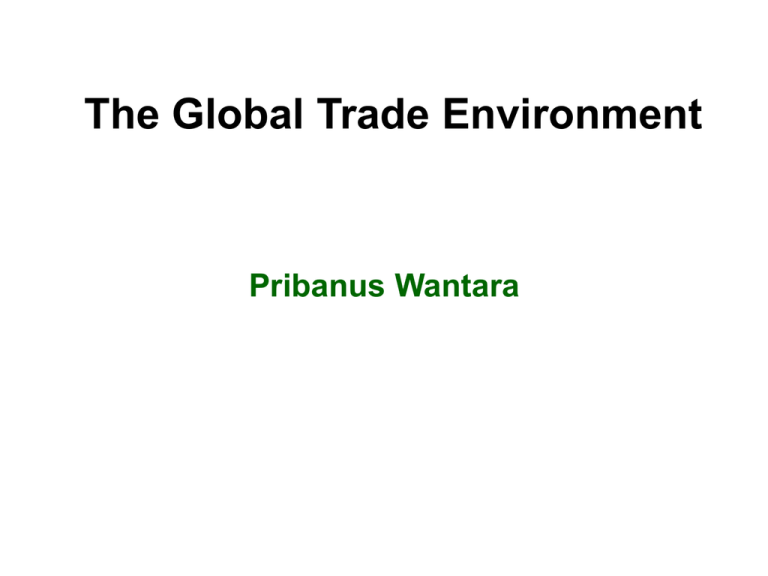
The Global Trade Environment Pribanus Wantara GATT • General Agreement on Tariffs and Trade – Treaty among nations to promote trade among members established in 1947 • Handled trade disputes • Lacked enforcement power • Replaced by World Trade Organization in 1995 3-2 The World Trade Organization • Forum for trade-related negotiations among 153 members – Based in Geneva – Serves as dispute mediator through DSB (The Dispute Settlement Body) – Has enforcement power and can impose sanctions 3-3 WTO Structure 3-4 Preferential Trade Agreements • Many countries seek to lower barriers to trade within their regions • PTAs give partners special treatment and may discriminate against others • Over 300 PTAs have been notified to the WTO 3-5 Hierarchy of PFTs CET = Common External Tariffs Free Trade Area • Two or more countries agree to abolish tariffs and other barriers to trade amongst themselves • Countries continue independent trade policies with countries outside agreement • Rules of origin requirements restrict transshipment of goods from the country with the lowest tariff to another NAFTA Protest in Ottawa 3-7 North America—NAFTA • Canada, United States, Mexico • NAFTA established a free trade area in 1994 –All three nations pledge to promote economic growth through tariff reductions and expanded trade and investment –No common external tariffs –Restrictions on labor and other movements remain 3-8 U.S.-Mexico Border Crossing NAFTA Income and Population 3-9 Customs Union • Evolution of Free Trade Area • Includes the elimination of internal barriers to trade (as in FTA) • AND establishes common external barriers to trade • Examples: The EU and Turkey, the Andean Community, Mercosur, CARICOM, Central American Integration System (SICA) 3-10 Common Market • Includes the elimination of internal barriers to trade (as in free trade area) • AND establishes common external barriers to trade (as in customs union) • AND allows for the free movement of factors of production, such as labor, capital, and information 3-11 Economic Union • Includes the elimination of internal barriers to trade (as in free trade area) • AND establishes common external barriers to trade (as in customs union) • AND allows for the free movement of factors of production, such as labor, capital, and information (as in common market) • AND coordinates and harmonizes economic and social policy within the union 3-12 Economic Union European Union Flag • Full evolution of economic union – creation of unified central bank – use of single currency – common policies on issues such as agriculture, social policy, transport, competition, mergers, taxation – requires extensive political unity – would lead to a central government in time 3-13 U.S. Goods Exports in 2009 $1.27 Trillion 3-14 U.S. Goods Imported in 2009 $2.1 Trillion 3-15 Latin America: SICA, Andean Community, Mercosur, CARICOM • Includes the Caribbean, Central, and South America • History of no growth, inflation, debt, and protectionism has given way to free markets, open economies, and deregulation • Some concern for further growth with the rise of left-leaning politicians 3-16 Central American Integration System (SICA) • El Salvador, Honduras, Guatemala, Nicaragua, Costa Rica, and Panama • Moving towards a common market • Common External Tariff of 0 to 15% • Retains tariffs on goods also produced in importing country 3-17 Andean Community • Bolivia, Colombia, Ecuador, Peru • Customs Union – Abolished foreign exchange, financial and fiscal incentives, and export subsidies – Established common external tariffs 3-18 Common Market of the South (MERCOSUR) • Argentina, Brazil, Paraguay, Uruguay, Venezuela • Customs union, seeks to become common market – Internal tariffs eliminated – Established common external tariffs up to 20% – In time, factors of production will move freely through member countries • Bolivia, Chile, Ecuador, Peru – Associate members – Participate in free trade area but not customs union 3-19 MERCOSUR 3-20 Caribbean Community and Common Market (CARICOM) 3-21 CARICOM 3-22 Asia-Pacific: The Association of Southeast Asian Nations (ASEAN) • Brunei, Cambodia, Indonesia, Laos, Malaysia, Myanmar, Philippines, Singapore, Thailand, Vietnam • Trading partners U.S., EU, China • Geographically close; historically divided • “ASEAN plus six” (Japan, China, Korea, Australia, New Zealand, India) working towards an economic community ASEAN 3-24 Singapore • • • • • • World’s 2nd largest container port 2nd highest standard of living in the region behind Japan 4.2 million people 93% literacy rate Over 3,000 companies Crime is nearly nonexistent 3-25 The European Union (EU) • Initially began with the 1958 Treaty of Rome • Objective is to harmonize national laws and regulations so that goods, services, people, and money could flow freely across national boundaries 1991 Maastricht Treaty set stage for transition to an economic union with a central bank and single currency (the Euro) 3-26 European Union • • • • • • • 27 countries 500 million people $15 trillion GNI Euro currency, 1999 Harmonization of laws and regulations Price transparency No customs at national borders 3-27 The Middle East • Afghanistan, Bahrain, Cyprus, Egypt, Iran, Iraq, Israel, Jordan, Kuwait, Lebanon, Oman, Qatar, Saudi Arabia, Syria, the United Arab Emirates, Yemen – Primarily Arab, some Persian and Jews – 95% Muslim, 5% Christian and Jewish – Oil prices drive commerce – 25% of world’s oil in Saudi Arabia – Arab Spring 2011 3-28 Gulf Cooperation Council •Established in 1981 by 6 countries with 45% of world’s oil •These countries are attempting to diversify industries 3-29 Africa • 54 nations over three distinct areas – Republic of South Africa – North Africa – Black Africa or sub-Saharan Africa • Mena: Middle East and North Africa – Viewed as a regional entity • Regional agreements – Economic Community of West African States – East African Cooperation – South African Development Community 3-30 Looking Ahead to Chapter 4 • Social and Cultural Environments 3-31
